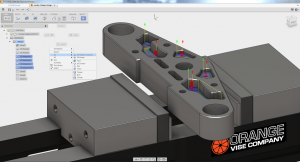Autodesk’s new CAM 360 got a big piece of the spotlight at Autodesk University 2013. The new product is part of the growing line of cloud-based products, key to Autodesk’s evolving business model.
One of the major centerpieces of Autodesk University was the unveiling of CAM 360, Autodesk’s latest 360 cloud-based product. Autodesk says CAM 360 is CAM redefined. The new product includes a streamlined version of Fusion, access to simulation tools, and collaboration. This is part of a major Autodesk initiative that brings together rapid prototyping, collaboration, and community. Autodesk sees direct manufacture tools including CAM and rapid prototyping as key weapons in the battle for the next generation of manufacturing.
At Autodesk University the company spent quite a bit of its face-time budget with press and analysts educating them on the potential of cloud-based manufacture techniques. Although there has been considerable attention paid to 3D printing and additive manufacturing techniques, Autodesk clearly believed it was time to highlight CAM as a mature technology that is fast, cheap, and widely used.
The first product for CAM 360 is built on Autodesk’s HSM technology acquired last year. At that time, HSMWorks was complementary to SolidWorks. Autodesk has continued to support that product, finding benefit in having SolidWorks users as partners, and it has added on Inventor HSM. CAM 360 is built on the same kernel as these other products and its inclusion of Fusion means customers can work with a part from any CAD product, bring it into Fusion, refine it and get to work.

You have designed your last bracket
Putting it in the sky, Autodesk argues, transforms CAM. One of the themes at Autodesk University was the idea of re-use. When it come to designing a simple part, why do it over when it’s been designed many times before? In the case of a simple bracket, argued CEO Carl Bass in his talks at AU, why not use a bracket design that has been shared online or for sale for much less than the time it would take to design it yourself. In addition, people may want to collaborate on a part from different locations and work directly with customers and co-workers.
CAM 360 will become available next year. The company says they’ll start with free two-and-a-half axis CAM to encourage people to try out the tools, then they will add on more complex products with pricing that will go up accordingly as well. Just this month Autodesk announced plans to acquire CAM leader Delcam (see “Autodesk to acquire CAM leader Delcam.”). Autodesk can’t talk about their plans for UK-based Delcam until the deal closes. But clearly, Delcam’s technology is part of the CAM 360 plan.
Autodesk VP Brenda Discher is heading Autodesk’s Manufacturing 360 team. She says CAM 360 is the result of lessons learned as the company has introduced products in the 360 line. They have been able to get new products out faster as they build on the technology that has gone before including Fusion, SIM 360, and the Autodesk 360 dashboard tools.
There is also real momentum building among users, say Autodesk’s execs. Discher says more than 17,000 people have signed up for Fusion 360, and they’re turning out 300 designs a day. Rendering in the cloud is going crazy says Carl Bass. How crazy? Senior Vice President Andrew Anagnost said 5.6 million renderings have been run. The number of renders has increased 6x since 2012. And, even more significant for Autodesk, most of the people trying out new online products are new to Autodesk.
The big picture is getting bigger
Rendering, CAM, Simulation – all these capabilities can be used with models created in other products outside the Autodesk family. Autodesk is growing its community, and as people work with these tools they will be interacting with other users who use Autodesk’s tools. Carl Bass said, “What we are increasingly seeing is that it’s not a heterogeneous world. There are very few customers who don’t use our tools for something.”
Instead of fencing in customers, Autodesk is coming to see a big advantage in building a bigger tent and inviting everyone in.
What do we think?
There’s a lot more to say about Autodesk University and we’ll get to it, but the introduction of CAM 360 says a lot about how Autodesk is making itself more adaptable for the future and how it is building a new business model that puts it in touch with millions more customers and potential customers.





